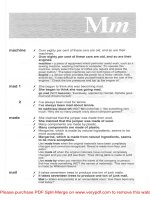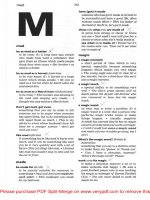2 6 28 ready for lift off (science)
Bạn đang xem bản rút gọn của tài liệu. Xem và tải ngay bản đầy đủ của tài liệu tại đây (591.86 KB, 14 trang )
by Ann Takman
H O UG H T O N MIF F L IN
by Ann Takman
PHOTOGRAPHY CREDITS: Cover © Stockbyte/Getty Images. 1 Stocktrek Images/Getty Images. 2 Atlas Photo Bank/
Photo Researchers, Inc. 3 NASA/Photo Researchers, Inc. 4 NASA. 6 NASA. 7 NASA. 8 Stocktrek Images/Getty Images.
9 NASA. 10 Stockbyte/Getty Images.
Copyright © by Houghton Mifflin Company. All rights reserved.
No part of this work may be reproduced or transmitted in any form or by any means, electronic or mechanical, including
photocopying or recording, or by any information storage or retrieval system without the prior written permission of the
copyright owner unless such copying is expressly permitted by federal copyright law. With the exception of nonprofit transcription into Braille, Houghton Mifflin is not authorized to grant permission for further uses of this work. Permission must
be obtained from the individual copyright owner as identified herein. Address requests for permission to make copies of
Houghton Mifflin material to School Permissions, Houghton Mifflin Company, 222 Berkeley Street, Boston, MA 02116.
Printed in China
ISBN-13: 978-0-547-02988-7
ISBN-10: 0-547-02988-8
1 2 3 4 5 6 7 8 9 SDP 15 14 13 12 11 10 09 08
This is a space shuttle.
It looks like an airplane,
but it travels in space.
Astronauts have explored space
in space shuttles since 1981.
2
Astronauts must learn how to
work in space.
They study subjects such as
astronomy and math.
They learn how to move
and live in space, too.
3
Many people help astronauts
get ready to fly.
A launch team gets the space shuttle
ready to fly.
They check the orbiter to be sure
its parts work correctly.
The orbiter carries astronauts
and equipment.
The launch team fixes any parts of
the orbiter that need repair.
4
Space Shuttle
External tank
Solid rocket booster
Solid rocket booster
Orbiter
Orbiter engines
The launch team tests and checks
the external tank.
This tank holds fuel.
The launch team tests and checks
the solid rocket boosters.
These boosters hold fuel, too.
5
A team puts together the solid rocket
boosters, the external tank, and the
orbiter to form the space shuttle.
6
The team puts very cold fuel into
the external tank.
The fuel is so cold that ice forms
on the tank.
A few hours before launch,
another team makes sure that
there isn’t too much ice on the tank.
7
Solid rocket
boosters
Orbiter engines
At liftoff, the solid rocket boosters
begin to work.
Their force helps push the shuttle
off the ground.
After about two minutes,
the boosters float back to Earth.
8
At liftoff, the orbiter engines work.
They also push the shuttle
off the ground.
They get the shuttle into space.
The engines use fuel
from the external tank.
The tank is empty after about eight
minutes, and then it falls away, too.
9
Now the orbiter can orbit Earth.
In the future, many people
may travel by space shuttle.
Maybe you will be one of them!
10
Responding
Word Builder Make
a word web around the word space. What
might you see in space? Copy this word
web and add more words.
TARGET VOCABULARY
space shuttle
?
space
?
?
Write About It
Text to Self You have just read about the
space shuttle. Would you like to fly in
one? Write a few sentences telling why or
why not. Use two words from the Word
Builder in your paragraph.
11
TARGET VOCABULARY
astronomy
explored
float
force
future
orbit
repair
space
Analyze/Evaluate Tell
how you feel about the text, and why.
TARGET STRATEGY
On the water sits a boat. It does
not sink because it can
.
12
Level: L
DRA: 24
Science
Strategy:
Monitor/Clarify
Word Count: 294
2.6.28 Build Vocabulary
HOUGHTON MIFFLIN
Online Leveled Books
1033122









